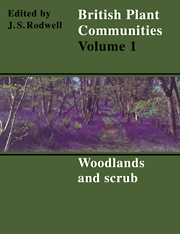Book contents
- Frontmatter
- Contents
- List of Figures
- Foreword
- Preface and Acknowledgements
- Preamble
- General Introduction
- Woodlands and Scrub
- Introduction to Woodlands and Scrub
- Key To Woodlands and Scrub
- Community Descriptions
- W1 Salix Cinerea-Galium Palustre woodland
- W2 Salix Cinerea-Betula Pubescens-Phragmites Australis Woodland
- W3 Salix Pentandra-Carex Rostrata Woodland
- W4 Betula Pubescens-Molinia Caerulea Woodland
- W5 Alnus Glutinosa-Carex Paniculata Woodland
- W6 Alnus Glutinosa-Urtica Jzozca Woodland
- W7 Ainus Glutinosa-Fraxinus Excelsior-Lysimachia Nemorum Woodland
- W8 Fraxinus Excelsior-Acer Campestre-Mercurialis Perennis Woodland
- W9 Fraxinus Excelsior-Sorbus Aucuparia-Mercurialis Perennis Woodland
- W10 Quereus Robur-Pteridium Aquilinum-Rubus Fruticosus Woodland
- W11 Quereus Petraea-Betula Pubescens-Oxalis Acetosella Woodland
- W12 Fagus Sylvatica-Mercurialis Perennis Woodland
- W13 Taxus Baccata Woodland
- W14 Fagus Sylvatica-Rubus Fruticosus Woodland
- W15 Fagus Sylvatica-Deschampsia Flexuosa Woodland
- W16 Quereus spp.-Betula spp.-Deschampsia Flexuosa Woodland
- W17 Quereus Petraea-Betula Pubescens-Dicranum Majus Woodland
- W18 Pinus Sylvestris-Hylocomium Splendens Woodland
- W19 Juniperus Communis Ssp. Communis-Oxalis Acetosella Woodland
- W20 Salix Lapponum-Luzula Sylvatica Scrub
- W21 Crataegus monogyna-Hedera helix scrub
- W22 Prunus Spinosa-Rubus Fruticosus Scrub
- W23 Ulex Europaeus-Rubus Fruticosus Scrub
- W24 Rubus Fruticosus-Holcus Lanatus Underscrub
- W25 Pteridium Aquilinum-Rubus Fruticosus Underscrub
- Index of Synonyms to Woodlands and Scrub
- Index of Species in Woodlands and Scrub
- Bibliography
W22 - Prunus Spinosa-Rubus Fruticosus Scrub
Published online by Cambridge University Press: 04 July 2020
- Frontmatter
- Contents
- List of Figures
- Foreword
- Preface and Acknowledgements
- Preamble
- General Introduction
- Woodlands and Scrub
- Introduction to Woodlands and Scrub
- Key To Woodlands and Scrub
- Community Descriptions
- W1 Salix Cinerea-Galium Palustre woodland
- W2 Salix Cinerea-Betula Pubescens-Phragmites Australis Woodland
- W3 Salix Pentandra-Carex Rostrata Woodland
- W4 Betula Pubescens-Molinia Caerulea Woodland
- W5 Alnus Glutinosa-Carex Paniculata Woodland
- W6 Alnus Glutinosa-Urtica Jzozca Woodland
- W7 Ainus Glutinosa-Fraxinus Excelsior-Lysimachia Nemorum Woodland
- W8 Fraxinus Excelsior-Acer Campestre-Mercurialis Perennis Woodland
- W9 Fraxinus Excelsior-Sorbus Aucuparia-Mercurialis Perennis Woodland
- W10 Quereus Robur-Pteridium Aquilinum-Rubus Fruticosus Woodland
- W11 Quereus Petraea-Betula Pubescens-Oxalis Acetosella Woodland
- W12 Fagus Sylvatica-Mercurialis Perennis Woodland
- W13 Taxus Baccata Woodland
- W14 Fagus Sylvatica-Rubus Fruticosus Woodland
- W15 Fagus Sylvatica-Deschampsia Flexuosa Woodland
- W16 Quereus spp.-Betula spp.-Deschampsia Flexuosa Woodland
- W17 Quereus Petraea-Betula Pubescens-Dicranum Majus Woodland
- W18 Pinus Sylvestris-Hylocomium Splendens Woodland
- W19 Juniperus Communis Ssp. Communis-Oxalis Acetosella Woodland
- W20 Salix Lapponum-Luzula Sylvatica Scrub
- W21 Crataegus monogyna-Hedera helix scrub
- W22 Prunus Spinosa-Rubus Fruticosus Scrub
- W23 Ulex Europaeus-Rubus Fruticosus Scrub
- W24 Rubus Fruticosus-Holcus Lanatus Underscrub
- W25 Pteridium Aquilinum-Rubus Fruticosus Underscrub
- Index of Synonyms to Woodlands and Scrub
- Index of Species in Woodlands and Scrub
- Bibliography
Summary
Synonymy
Scrub auct. angl. p.p.; Scrub associations Tansley 1911; Cliff Scrub Nodum Malloch 1970 p.p.; Primula vulgaris-Prunus spinosa Association (R. Tx 1952) Birse 1980.
Constant species
Prunus spinosa.
Physiognomy
Prunus spinosa is a frequent and locally abundant species in the Crataegus-Hedera scrub but, in this community, it is the sole woody constant and almost always an overwhelming dominant in a consistently more speciespoor canopy. Indeed, it is usually the only tree or shrub present, though Ulex europaeus is occasional on more base-poor soils and Corylus avellana and Ligustrum vulgare can occur on the more base-rich. The height of the canopy is rather variable, but generally quite low, well-grown Prunus in sheltered situations typically attaining no more than 4 m and scrub in very exposed places, as on some sea-cliffs, having a cover often less than 1 m. Usually the canopy is closed or almost so, being especially dense where the trees are wind-pruned.
Undershrubs are not numerous, though there is often some Rubus fruticosus agg., growing sparsely beneath the Prunus or, more obviously, forming a thick tangled fringe. R. idaeus also occurs occasionally and can be locally abundant and there can be some roses, usually Rosa canina with R. dumalis, R. tomentosa and R. sherardii recorded more rarely (Birse 1980). Woody sprawlers and climbers are uncommon, but Lonicera periclymenum is occasional and, to the south-west, Rubia peregrina may be found.
The field layer of the Prunus scrub is characteristically species-poor and often rather sparse, especially in denser stands, where it is limited to a patchy cover beneath the trees themselves and a marginal belt. Pteridium aquilinum is the commonest species throughout, though it is only locally abundant and often reduced to scattered fronds. Urtica dioica and Galium aparine also occur frequently, the latter often sprawling in some abundance up the scrub fringes. Then, there are often some grasses, though the species represented vary somewhat in the different sub-communities. Poa trivialis and Holcus mollis are among the commonest but H. lanatus and Agrostis capillaris occur throughout and there can also be some Brachypodium sylvaticum, Festuca rubra and Dactylis glomerata. A further quite frequent component, though less universally prominent here than in the Crataegus-Hedera scrub, is a ground carpet of Hedera helix.
- Type
- Chapter
- Information
- British Plant Communities , pp. 347 - 351Publisher: Cambridge University PressPrint publication year: 1991

